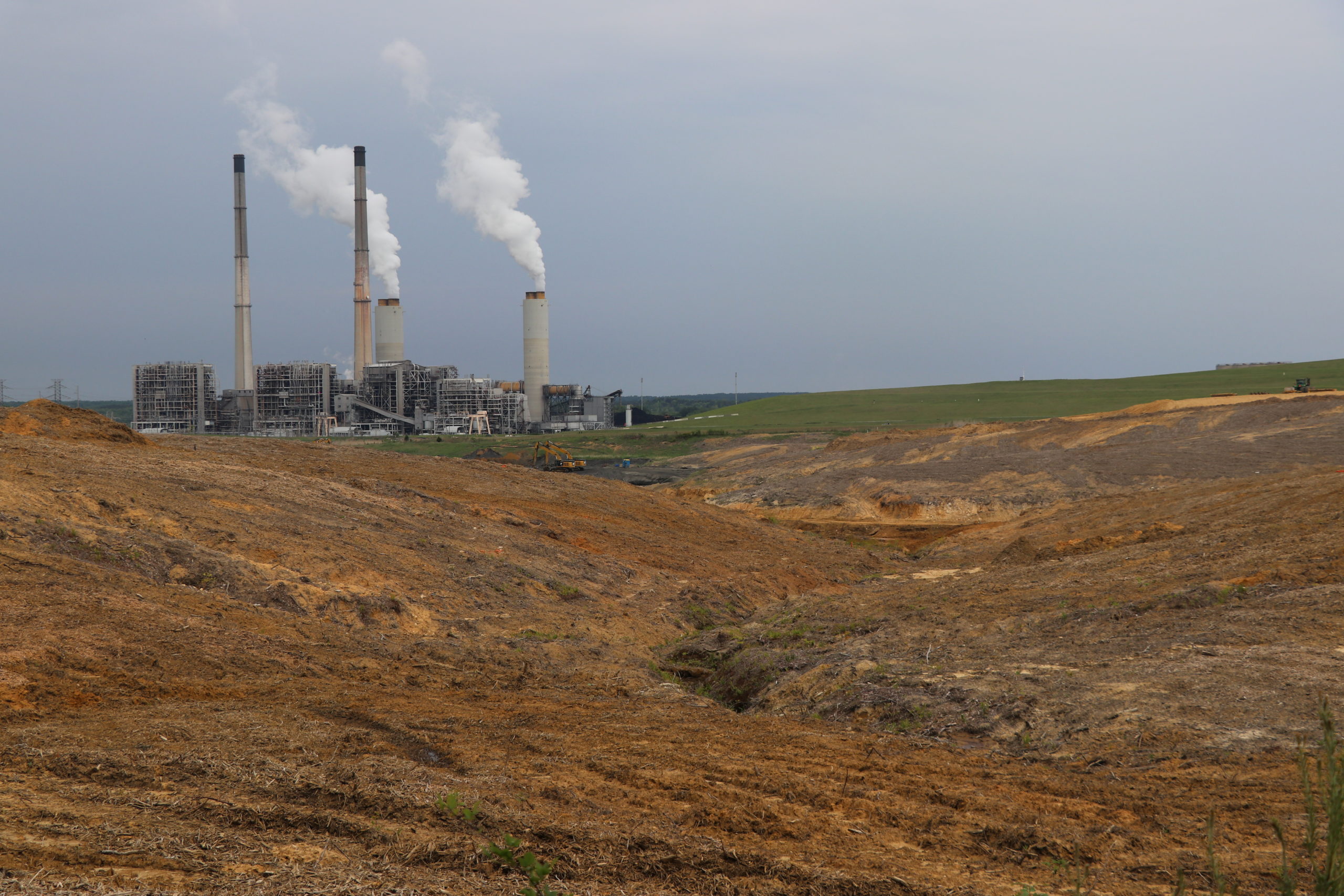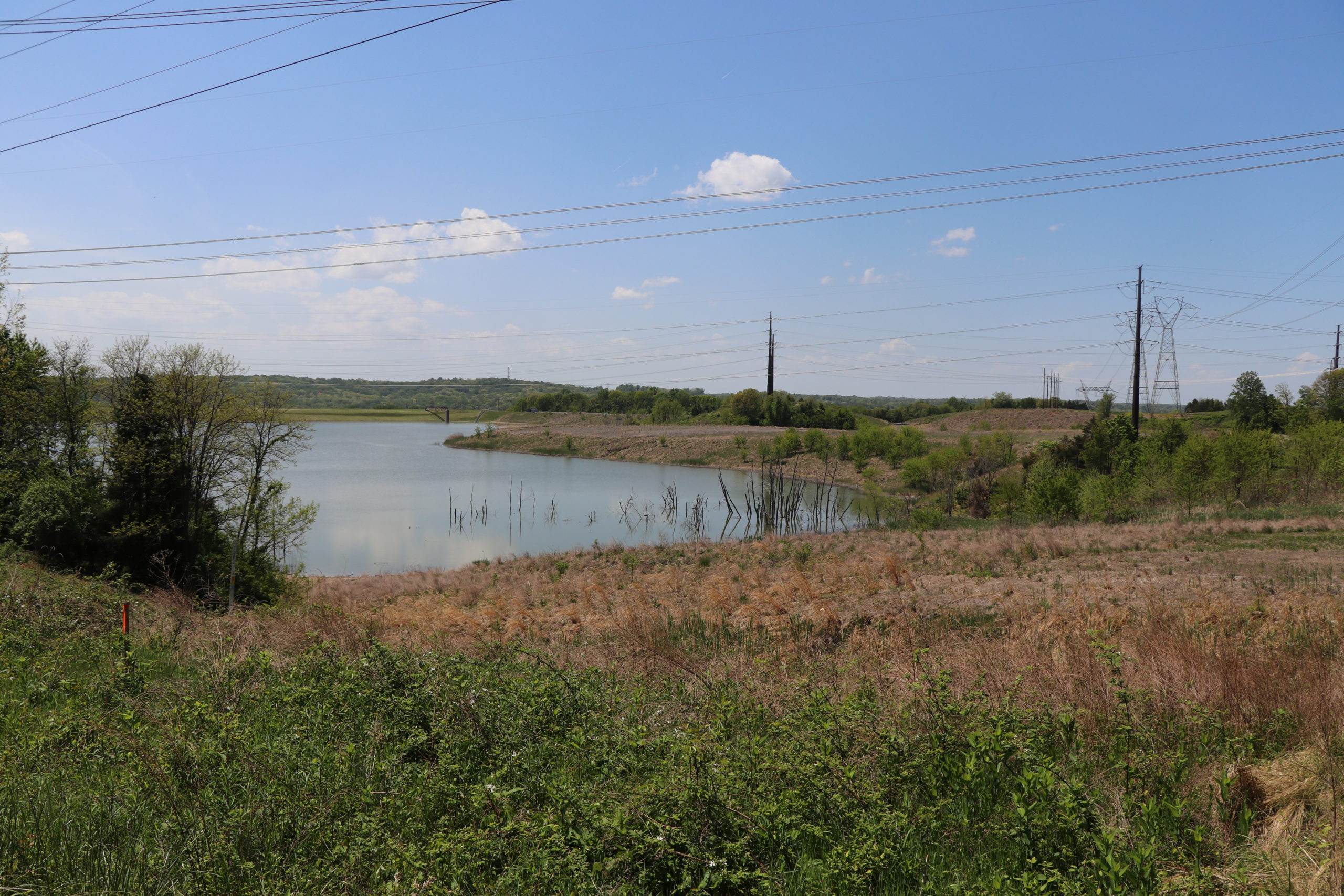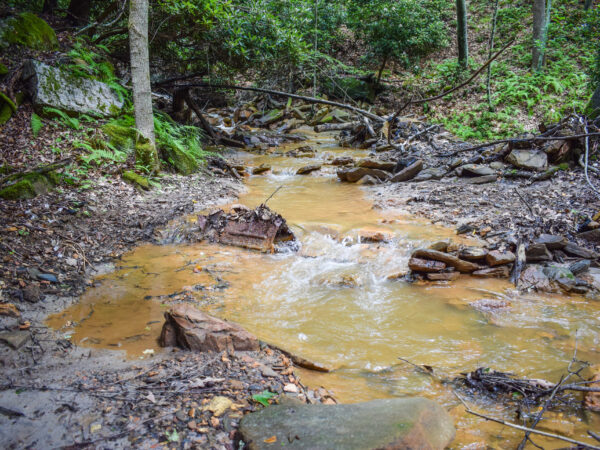
Eighty-eight-year-old Hilda Barg hunched her shoulders and rested her forearms on her hardwood dining table, talking fiercely about coal ash contamination in her neighborhood. Barg, a lifelong resident and former supervisor of Prince William County, Virginia, is leading a local fight against how Dominion Energy — the state’s largest electric utility — is dealing with toxic coal ash at its Possum Point plant 3 miles from Barg’s home.
“I’m old — I won’t be around long,” Barg said. “But I want our children to have clean water and not have contaminants in their backyard.”
Perhaps ironically, the Dominion plan Barg is railing against is often considered to be the safest way for companies to deal with coal ash. Dominion plans to remove coal ash from pits, where it risks contaminating groundwater, and store it in a lined landfill on the same site. This avoids transporting the ash through communities. But Barg and her neighbors say they’ve dealt with the ash for long enough, and they want it gone.
Barg’s son Larry Waite has a supply of bottled water delivered to his house every week or two, since his private well was found to be contaminated, likely as a result of nearby coal ash.
Possum Point stopped burning coal in 2003, but like hundreds of sites nationwide, it still has tons of residual toxic coal ash sitting in pits next to the plant, near where the 14-mile-long Quantico Creek meets the Potomac River.
Testing by Prince William County officials found lead and boron above limits considered safe in wells at two homes near the coal ash, according to official documents. Dominion Energy has paid for nine homeowners’ connections to municipal water because of concerns about coal ash contamination, and is paying for other residents to have bottled water delivered, said spokesperson Matt Long.
Some residents think the contamination could have been more widespread. In 2015, Barg spent almost $5,000 out-of-pocket to install a water purifying system in her house, out of fear her well was contaminated. She said Dominion later that year tested water from the faucets in her home, but she no longer has the results and was upset they didn’t test the well itself.
“I want to see Dominion step up to the plate, admit they’re wrong, and do the correction,” she said.
Power companies are obligated under the 2015 federal coal ash rule to monitor groundwater and decide how to close their coal ash ponds. In most cases, companies have proposed to close the coal ash repositories in place, often leaving coal ash in contact with earth and groundwater. Environmental groups advocate for removing the ash and putting it in lined landfills.
Legislation and legal settlements in Virginia, North Carolina and South Carolina have led utility companies to agree to excavate hundreds of millions of tons of ash and place it in safer, lined landfills — as Dominion is doing at Possum Point.
The excavation in these states is considered a historic undertaking, and a possible model for states like Ohio and Indiana where companies are planning to leave millions of tons of coal ash in place despite evidence of groundwater contamination. However, even where excavation is planned, many communities — like Possum Point — still have concerns about groundwater contamination and the harmful impacts of the removal. In Memphis, for example, residents are furious that coal ash from a nearby power plant is being moved to a landfill also in their community. Residents in Uniontown, Alabama, and Pickens County, South Carolina, are among others that stridently oppose local landfills storing coal ash.
North Carolina’s path to excavation
On Feb. 2, 2014, a storm sewer leak caused at least 50,000 tons of ash and 27 million gallons of ash basin water to spill into the Dan River in Eden, North Carolina, according to the EPA. The ash and contaminated water flowed downstream through North Carolina and Virginia, spreading over 70 miles. The Dan River spill is considered one of the largest coal ash spills in U.S. history.
It launched the state’s scrutiny of its coal ash risk, ultimately resulting in both legislation and legal settlements.
“I would say the legislative interest increased greatly after the Dan River spill,” said Rep. John Szoka, chair of North Carolina’s Energy and Public Utilities Committee. “At that point in time, it became apparent that we needed to do something.”
The 2014 Coal Ash Management Act mandated that four Duke Energy sites designated as “high risk” — Dan River, Sutton, Asheville, and Riverbend — needed to close by 2019, with all the ash removed. According to Duke’s 2021 annual report, three sites have been fully excavated. All the ash was removed from the Asheville site in June, according to a Duke spokesperson.
“One of the challenges, when we drafted initial legislation, was that there was little to go on from other states, or from the federal government,” Szoka said. “I would say that North Carolina was the leader in coal ash legislation and how to clean it up.”
In May 2015, Duke Energy was charged with nine criminal violations of the Clean Water Act related to the Dan River spill and other coal ash sites. The charges included failure to maintain equipment at its Dan River and Cape Fear sites, and unlawful discharge of coal ash and coal ash wastewater at several plants.
The company pled guilty to the charges and was ordered to pay a total of $102 million. Of the total amount, $68 million went toward paying a criminal fine and $34 million went toward environmental projects in North Carolina and Virginia.
In 2019, the North Carolina Department of Environmental Quality reached a settlement agreement with Duke Energy mandating the company excavate coal ash at its six remaining active sites.
The 2019 settlement combined with the 2014 state law means that Duke is now legally required to close and excavate all its North Carolina ash ponds, and put the ash in lined landfills. Active coal plants must put their ash directly into landfills.
In total, Duke is set to excavate over 125 million tons of coal ash by 2038 — the largest excavation project of its kind in U.S. history.
“This closes the chapter on the outdated practice of storing coal ash in open, unlined pits in North Carolina and protects the public health and the environment,” said Michael S. Regan, then North Carolina Department of Environmental Quality secretary and current head of the EPA, in a press release about the excavation.
South Carolina cleanup
In 2012, the Southern Environmental Law Center sued Dominion Energy over coal ash storage at its Wateree Station in South Carolina, where the center alleged years of runoff from coal ash ponds created a small “creek” containing high levels of arsenic flowing into the Wateree River.
Ultimately legal agreements — as in North Carolina — led to both Dominion Energy and Duke Energy committing to remove coal ash from their sites in the state.
Dominion began excavating ash at Wateree in 2013 and finished in 2019, with more than 3.5 million tons of coal ash moved to a lined, off-site landfill or recycled. Before the removal, there were elevated levels of arsenic in the nearby groundwater. Testing in 2016 showed arsenic levels meeting safety standards.
Meanwhile in 2014, on the heels of the Dan River spill and North Carolina’s Coal Ash Management Act, Duke and South Carolina regulators entered an agreement requiring coal ash excavation at the company’s two coal plants in the state: Robinson and W.S. Lee.
As in North Carolina, the ash will be placed in lined landfills on-site. Since Duke promised to remove the ash, the state agreed not to hold the company liable for any future damages at the ash basins. So far, almost half of the 8.3 million tons of coal ash at the two plants has been excavated. W.S. Lee is projected to finish excavation first in 2029, with Robinson completing its closure in 2035.
State leaders also fought against coal ash from other states being dumped in South Carolina commercial landfills.
In May, Pickens County, located just west of Greenville, settled a six-year legal battle over the local landfill company MRR Pickens’ attempts to accept coal ash from across state lines. The company allegedly applied for a permit to accept coal ash, which town officials claim they were never made aware of. The county revoked the landfill’s land-use agreement, then the company sued.
The case made its way to the South Carolina Supreme Court, and it ended in a settlement that prohibits coal ash from being dumped in the landfill. The settlement also prohibits MRR Pickens from putting a liner on the landfill since that could help it gain permission to accept coal ash in the future.
The lengthy court case got so much attention that in 2016, then-Gov. Nikki Haley signed a bill banning the dumping of out-of-state coal ash into unlined landfills. The law required coal ash to be placed in lined Class-3 landfills designated for “special wastes.”
“In the Southeast, due to citizen concerns, enforcement litigation, and ultimately some government action, we have made significant progress,” said Frank Holleman, senior attorney at the Southern Environmental Law Center.
Virginia: Polluted wells and legislative action
Virginia state lawmakers passed a bill in 2019 that forced electric utilities to excavate coal ash from all ash ponds, and either store it in lined landfills or recycle it for use in manufacturing concrete or building roads. The law also mandates that utilities pay to connect every residence within one and a half miles of coal ash with municipal water systems. If such a connection is not feasible, utilities need to provide well water testing for residents.
Under this regulation, Dominion Energy sampled 29 private wells in Prince William County last year and found radium exceedances in six of them, and cadmium in one. Radium and cadmium are toxic carcinogens found in coal ash.
In 2016, Dominion Energy released untreated water from an ash pond into nearby Quantico Creek. That led the town council to unanimously vote to request the EPA launch a criminal investigation into the relationship between state regulators and Dominion Energy.
“Quantico Creek, that’s where I used to fish when I was a kid,” Barg said, “until it was all destroyed. The quality of the water was destroyed by Dominion.”

Power lines hang across Quantico Creek, connecting Prince William County to Dominion Energy’s Possum Point Plant. (Photo Credit: Hayley Starshak)
After almost four years of litigation, Dominion Energy was ordered to pay the state of Virginia $1.4 million over Clean Water Act violations related to the wastewater release.
In 2018, Dominion Energy tested the groundwater around Possum Point Station and detected high levels of contaminants such as boron and chlorides. Elevated levels of carcinogenic heavy metals such as arsenic, beryllium, lithium, and radium were found in two of the groundwater monitoring wells. Soon after, Dominion Energy announced closure plans for four out of the five active ash ponds, and consolidated the ash from four unlined ponds into one lined one.
But even after the ash was moved out of unlined ponds, groundwater contamination has apparently continued at Possum Point. Last year, testing found high levels of arsenic in groundwater.
In January, Dominion Energy announced plans to excavate the remaining 4 million cubic yards of coal ash from its lined pond and move it to an on-site, lined and capped landfill, as required by the state’s coal ash law. The on-site landfill is estimated to cost $347.1 million, with the ash excavation starting toward the end of 2026.
Barg and other residents are not happy. They want the coal ash to be taken completely out of their community, fearing it could contaminate water even from a landfill.
“No one is really looking at the health of the community,” Barg said. “I feel they’re looking at what’s the cheapest thing to do.”
No testing of private wells would be required after the coal ash is moved to the lined landfill.
The proposed towering landfill would sit 1,000 feet from Potomac Shores, a recently constructed housing development with homes that cost from $500,000 to almost $1 million. County officials have said the landfill would be 19 feet high.
“There are folks who don’t know what’s happening in their backyards,” Barg said. “Can you imagine looking out of your backyard at 19 feet of dirt, where you just paid $800,000 for your house?”
Barg was in charge of zoning for Potomac Shores during her tenure in the county government. But zoning was changed under the most recent county administration, she said, allowing homes to be built closer to the coal ash site.
She would like to see the ash taken by train to an off-site landfill. Dominion Energy studied the feasibility of transporting coal ash by rail from Possum Point to Dominion Energy’s Virginia City Hybrid Energy Center in Wise County, Virginia, according to Long. Dominion Energy estimated it would take 10 years to finish the cleanup by rail.
Dean Naujoks, the Potomac Riverkeeper, tested many drinking water wells at houses along Possum Point Road. He is part of a county task force on coal ash, and he’s pushing for Dominion Energy to recycle more ash for “beneficial reuse” — in making concrete, building roads and other structural uses.

Possum Point Road, a narrow two lane road in Prince William County, Virginia, leads to Dominion Energy’s Possum Point Station, which now runs on natural gas. (Photo Credit: Hayley Starshak)
Environmentalists and industry alike generally support coal ash reuse, since the contaminants that could otherwise pollute groundwater become chemically bound in a way that stops them from leaking into the ground.
In 2018, Dominion Energy assessed the feasibility of beneficially reusing coal ash from Possum Point, but a plan presented to residents of Prince William County in an online forum in January notes that Dominion prefers to move all the ash to the landfill, saying this would be much less expensive than other options. Coal ash can be safely recycled for use in concrete and other uses, though when ash has already been deposited in a pond, processing it for reuse can be costly and difficult. But the company has said the landfill would be the most cost-effective option.
“We’ve got plenty [of] ash in the state to give away for recycling,” Naujoks said. “Why aren’t we talking about that as a real viable solution?”
The cost of cleanup
Much of the controversy around coal ash excavation revolves around the struggle between environmental impact and keeping electricity rates low. In many states including Virginia, companies can pass on some or all of the costs of coal ash cleanup to ratepayers. When companies have to foot expenses, that also motivates them to pursue less costly, if less protective, options.
In North Carolina, extensive ratepayer cases argued before the Utilities Commission have determined how much Duke Energy is going to be able to charge customers for its coal ash excavation.
Duke estimates the full cost of cleaning up coal ash in the Carolinas to be $8 billion.
In 2021, Duke subsidiaries agreed to essentially cut more than $1 billion from the amount they planned to charge ratepayers for coal ash cleanup, by absorbing more than $700 million in cleanup costs themselves and reducing the profit they are allowed to earn on such investments.
In South Carolina, in 2019 the state Public Service Commission told Duke it could not bill South Carolina ratepayers for coal ash cleanup at its North Carolina plants. That meant Duke subsidiaries had to pay about $180 million in cleanup costs that they had hoped to pass on to ratepayers. Duke took the issue to the state Supreme Court but lost.
On the other hand, in Virginia, the 2019 Coal Ash Rule states that companies can bill ratepayers for basically all the costs associated with coal ash cleanup.
According to documents obtained through a public records request from the State Corporation Commission, ratepayers will need to pay an additional $3 per month for costs associated with coal ash cleanup at a few Dominion Energy stations, including Possum Point.
The big picture
Environmental advocates and lawyers say the excavation taking place in Virginia, North Carolina and South Carolina could serve as an example for other states.
Indiana has more coal ash basins and landfills than any other state in the country, the vast majority of them unlined.
Duke owns 17 of the 50 coal ash units in Indiana, according to the environmental organization Earthjustice’s analysis of data reported under federal rules.
In January, Duke received a letter from the EPA stating that the closure plans for the company’s Gallagher Station in New Albany were not sufficient to protect groundwater. The plans had earlier been approved by the state environmental regulatory agency. Duke withdrew the closure plans and will submit a new proposal to the state agency.
Similarly, Ohio has 21 unlined coal ash ponds, according to Earthjustice’s analysis of the data reported by companies. Many of these ash ponds are along the Ohio River, which runs through six states and supplies drinking water to more than 3 million people.

Ash Pond D at Dominion Energy’s Possum Point Plant. The 90 feet pond is slated for closure. (Photo Credit: Hayley Starshak)
The General James M. Gavin Plant in Cheshire, Ohio has two ash ponds, both unlined with a high hazard rating, meaning that the failure of ash impoundments would probably cause significant risk to human life. According to official closure plans, both the ash ponds at the Gavin Power Plant will be capped in place, not excavated.
“What’s happening in South Carolina, North Carolina and Virginia should be a model for the rest of the country,” Holleman said. “In fact, the cleanups underway in these states demonstrate that excavation is the industry standard for true remediation of coal ash sites, and that utilities are fully capable of achieving a complete cleanup if they want to, or are required to.”
Catch more news at Great Lakes Now:
Cracking down on coal ash: Tough talk and tough choices
In the Finger Lakes, a bitcoin mining plant billed as ‘green’ has a dirty coal ash problem
Featured image: White plumes billow out of Duke Energy’s Roxboro Plant in North Carolina. (Photo Credit: Hayley Starshak)
1 Comment
-
Years ago … 2000 …. we were boating up the Ohio in early October. We heard of a coal ash pond breaking. It was an unreported news event as there was a national political campaign going on. Nothing was reported Nationally. We were listening on my husband’s ham radio to the horrible event as the flow reached a small river that flows into the Ohio River. We turned around our boat and headed back down river to Indiana. When we reached home; and immediately took the boat out of the river. In a couple of days the ash reached our area as it flowed down river. There was NO NATIONAL NEWS.
I even did research on the event. Politically it was completely covered up.




